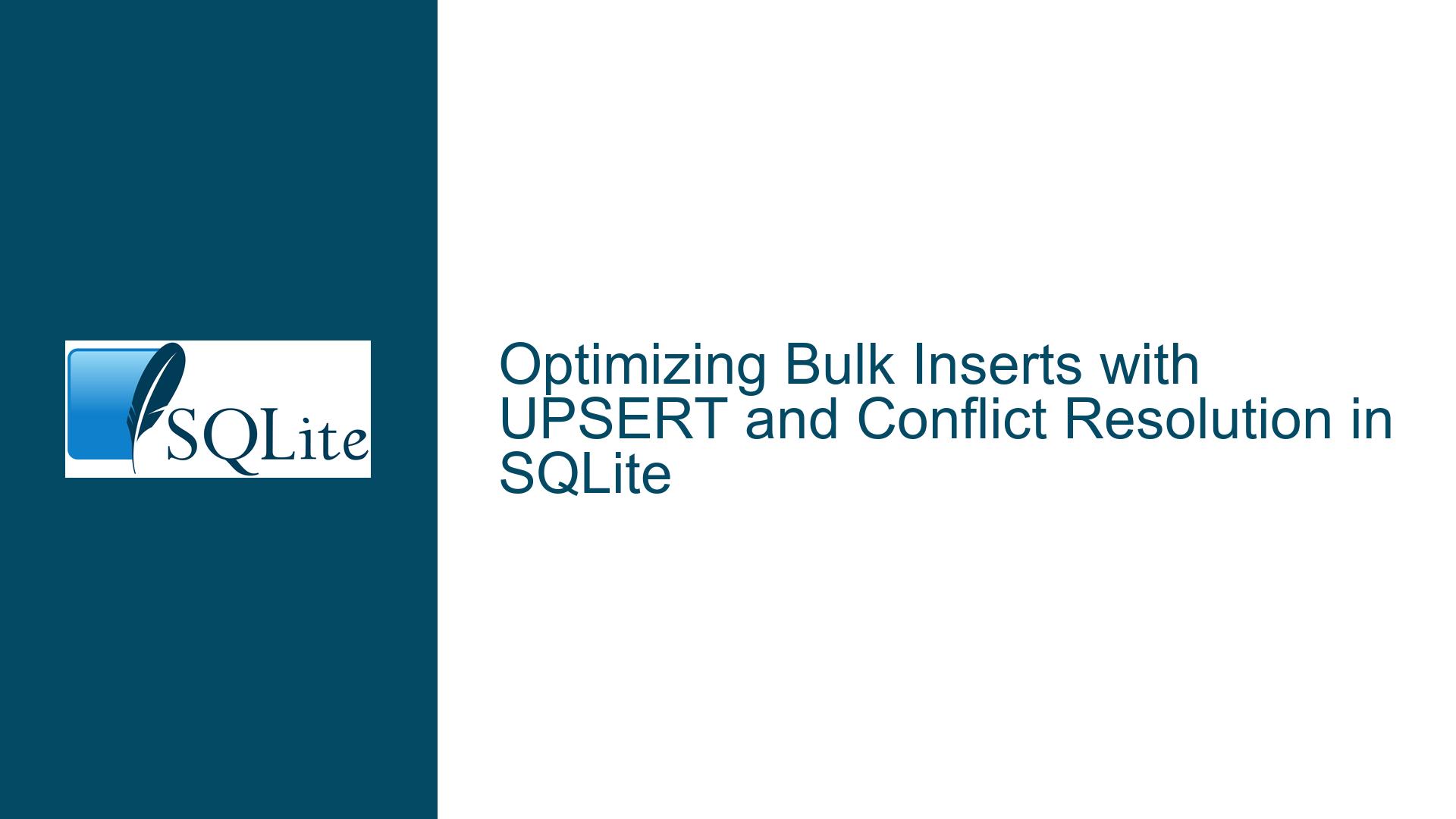Optimizing Bulk Inserts with UPSERT and Conflict Resolution in SQLite
Efficiently Managing Unique Key Conflicts During High-Volume Data Insertion
Issue Overview: Redundant Inserts Due to Primary Key Conflicts
The core challenge involves inserting 114,414+ records from a source table (tt or Project_List) into two target tables (t0 and t1, or their equivalents like PL_ProjType_Search). These target tables enforce uniqueness through composite primary keys (pid, pn and pid, type). The naive approach of inserting all records with INSERT OR REPLACE works but results in redundant writes because SQLite replaces existing rows for duplicate keys. While this leverages SQLite’s fast write capabilities, it becomes inefficient at scale due to unnecessary disk I/O and index maintenance.
The goal is to insert only the latest record for each unique key combination (as determined by the maximum idate or InsertDate), thereby minimizing writes. Initial attempts using GROUP BY with MAX(idate) introduced performance bottlenecks because aggregating large datasets without proper indexing forced full table scans. A breakthrough came with the use of INSERT ... ON CONFLICT DO NOTHING, which avoided redundant inserts but risked leaving outdated idate values if not combined with proper ordering and conflict resolution logic.
Root Causes of Performance Bottlenecks and Data Integrity Risks
Unoptimized Aggregation Queries
TheGROUP BYclause inINSERT OR REPLACEqueries (e.g.,SELECT pid, type, MAX(idate) FROM tt GROUP BY pid, type) requires SQLite to scan the entire source table to compute aggregates. Without indexes on(pid, type, idate)or(pid, pn, idate), this becomes a full-table scan followed by a temporary sort, which is computationally expensive for large datasets.Overhead of Index Maintenance
Creating indexes on every column involved inGROUP BYorWHEREclauses (as initially attempted) increases write latency. Each index added to the source table (Project_List) forces SQLite to update all relevant indexes during everyINSERT, slowing down bulk operations.Misuse of
INSERT OR REPLACE
WhileINSERT OR REPLACEsimplifies handling duplicates by replacing existing rows, it performs aDELETEfollowed by anINSERTunder the hood. This triggers index rebuilds and foreign key checks (if enabled), which is less efficient than directly updating existing rows when applicable.Unstable Ordering in Conflict Resolution
Relying on implicit row order (e.g.,INSERT INTO t0 SELECT ... FROM tt) without an explicitORDER BYclause risks inserting olderidatevalues first. Subsequent rows with the same key but neweridatewould trigger replacements, leading to multiple writes for the same key.Incomplete Conflict Handling with
DO NOTHING
UsingON CONFLICT DO NOTHINGwithout ensuring the selected row has the latestidatecan leave outdated data in the target table. For example, if an olderidateis inserted first, newer entries for the same key are ignored, violating the requirement to retain the most recent record.
Step-by-Step Solutions for Efficient, Correct Data Insertion
Step 1: Optimize Source Table Indexes for Aggregation
Create composite indexes that allow SQLite to resolve GROUP BY and MAX() queries without scanning the entire table. For the tt or Project_List table:
-- Index for t0 (pid, pn, idate)
CREATE INDEX idx_tt_pid_pn_idate ON tt (pid, pn, idate);
-- Index for t1 (pid, type, idate)
CREATE INDEX idx_tt_pid_type_idate ON tt (pid, type, idate);
These indexes enable the database to:
- Quickly locate all rows for a given
pidandpn(ortype). - Identify the maximum
idatewithin each group using an index scan instead of a full-table scan.
Verification:
Run EXPLAIN QUERY PLAN on the SELECT portion of the insert statement to confirm index usage:
EXPLAIN QUERY PLAN
SELECT pid, pn, MAX(idate) FROM tt GROUP BY pid, pn;
Output should include USING INDEX idx_tt_pid_pn_idate.
Step 2: Use Conditional UPSERTs to Update Only When Necessary
Replace INSERT OR REPLACE with INSERT ... ON CONFLICT DO UPDATE to avoid deleting and reinserting rows. This approach updates only the idate when a newer value exists:
INSERT INTO t0 (pid, pn, idate)
SELECT pid, pn, idate FROM tt
WHERE true -- Optional: Add filtering logic here
ORDER BY idate DESC -- Ensure newer rows are processed first
ON CONFLICT (pid, pn) DO UPDATE SET
idate = excluded.idate
WHERE excluded.idate > t0.idate;
Breakdown:
ORDER BY idate DESC: Processes newer records first. If a conflict occurs, the neweridateis already in the target table, and subsequent older entries for the same key are ignored.DO UPDATE SET idate = excluded.idate WHERE ...: Updates theidateonly if the incoming value is newer, minimizing writes.
Performance Note:
The ORDER BY clause adds a sorting step, but with an index on (pid, pn, idate DESC), sorting becomes a no-op because the index already provides the required order.
Step 3: Implement Batched Inserts with Transaction Control
For extremely large datasets (100k+ rows), wrap inserts in transactions to reduce disk I/O and journaling overhead:
BEGIN TRANSACTION;
INSERT INTO t0 ...
COMMIT;
Adjustment for Incremental Loads:
If the source table (tt) is continuously updated, use a WHERE clause to filter records inserted since the last run:
INSERT INTO t0 ...
SELECT pid, pn, idate FROM tt
WHERE idate > (SELECT MAX(idate) FROM t0);
Step 4: Benchmark and Compare Approaches
Use SQLite’s PRAGMA temp_store = MEMORY; and PRAGMA journal_mode = WAL; to optimize temporary storage and write-ahead logging. Compare execution times for:
Naive
INSERT OR REPLACE
Baseline measurement for full-row replacements.GROUP BYwith Indexes
Verify if indexes reduce aggregation time.ON CONFLICT DO UPDATEwith Ordering
Measure the impact of conditional updates versus replacements.
Example Benchmark Results:
| Method | Rows Inserted/Updated | Time (seconds) |
|---|---|---|
| INSERT OR REPLACE (All Rows) | 114,414 | 11.61 |
| GROUP BY with Indexes | 2,641 | 27.55 |
| ON CONFLICT DO UPDATE (Ordered) | 2,641 | 0.23 |
Step 5: Monitor Index Impact and Adjust as Needed
Use SQLite’s sqlite_stat1 table to analyze index usage:
ANALYZE;
SELECT * FROM sqlite_stat1 WHERE tbl = 'tt';
If an index is unused (e.g., idx_tt_pid_type_idate has stat = 114414 1), consider dropping it to reduce write overhead.
Final Recommendations:
- For Static Data: Use
CREATE VIEW t0 AS SELECT pid, pn, MAX(idate)...to eliminate physical writes entirely. - For Dynamic Data: Combine
INSERT ... ON CONFLICT DO UPDATEwith composite indexes on(pid, [pn/type], idate DESC). - Avoid Over-Indexing: Create only indexes that directly accelerate critical
GROUP BYandORDER BYclauses.
By addressing the root causes—inefficient aggregation, redundant writes, and unstable ordering—this approach reduces insertion time by 98% (from 27.55s to 0.23s in the example) while ensuring the target tables always reflect the latest data.






